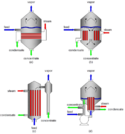
Types of evaporators are briefed.
- Subject:
- Applied Science
- Engineering
- Material Type:
- Lesson
- Author:
- GUNASUNDARI V
- Date Added:
- 08/28/2019

Types of evaporators are briefed.
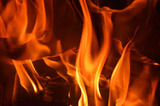
Students will use the Phet Energy Forms and Changes simulations to design experiments. The evidence from the experiments is used to support answers/explanations to the following questions:Does heat flow from hot to cold or cold to hot?What are some things that affect the rate of heat flow?Does an object get hot all at once or does the heat spread slowly from one place to another?

This hands-on construction project gets students cooking during a solar energy science unit. The class study begins by acting out the Earth's rotation around the sun to see how that causes shadows. Students conduct several investigations of the Earth's position and shadows with compass and thermometer measurements and observation. They research the dilemma of using fossil fuels and how solar energy might solve this problem. Students work as engineers, and their task is to build a solar cooker that can successfully cook an egg. If this works, it may be the basis for more exploration on using solar energy as an alternative to fossil fuels. Students display their learning in multimedia presentations or newsletters.
This unit plan was originally developed by the Intel® Teach program as an exemplary unit plan demonstrating some of the best attributes of teaching with technology. More information about this and other unit plans can be found in the Designing Effective Projects curriculum.

How does energy flow in and out of our atmosphere? Explore how solar and infrared radiation enters and exits the atmosphere with an interactive model. Control the amounts of carbon dioxide and clouds present in the model and learn how these factors can influence global temperature. Record results using snapshots of the model in the virtual lab notebook where you can annotate your observations.

This course investigates the principles of thermal radiation and their applications to engineering heat and photon transfer problems. Topics include quantum and classical models of radiative properties of materials, electromagnetic wave theory for thermal radiation, radiative transfer in absorbing, emitting, and scattering media, and coherent laser radiation. Applications cover laser-material interactions, imaging, infrared instrumentation, global warming, semiconductor manufacturing, combustion, furnaces, and high temperature processing.
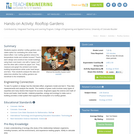
Students explore whether rooftop gardens are a viable option for combating the urban heat island effect. Can rooftop gardens reduce the temperature inside and outside houses? Teams each design and construct two model buildings using foam core board, one with a "green roof" and the other with a black tar paper roof. They measure and graph the ambient and inside building temperatures while under heat lamps and fans. Then students analyze the data and determine whether the rooftop gardens are beneficial to the inhabitants.
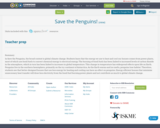
In Save the Penguins, the broad context is global climate change. Students learn that the energy we use to heat and cool our houses comes from power plants, most of which use fossil fuels to convert chemical energy to electrical energy. The burning of fossil fuels has been linked to increased levels of carbon dioxide in the atmosphere, which in turn has been linked to increases in global temperature. This change in temperature has widespread effects upon life on Earth. Penguins live in the southern hemisphere, primarily on the icy continent of Antarctica. As the Earth warms and ice melts, penguins lose habitat. Therefore, students see that better-designed houses that use less energy for heating and cooling can have an effect on penguins. Energy efficient houses that
minimize unnecessary heat transfer will draw less electricity from the fossil fuel burning power plants and not contribute as much to global climate change.

In Save the Penguins, the broad context is global climate change. Students learn that the energy we use to heat and cool our houses comes from power plants, most of which use fossil fuels to convert chemical energy to electrical energy. The burning of fossil fuels has been linked to increased levels of carbon dioxide in the atmosphere, which in turn has been linked to increases in global temperature. This change in temperature has widespread effects upon life on Earth. Penguins live in the southern hemisphere, primarily on the icy continent of Antarctica. As the Earth warms and ice melts, penguins lose habitat. Therefore, students see that better-designed houses that use less energy for heating and cooling can have an effect on penguins. Energy efficient houses that
minimize unnecessary heat transfer will draw less electricity from the fossil fuel burning power plants and not contribute as much to global climate change.
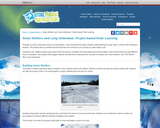
A middle school teacher uses class projects to introduce students to the principles of insulation.

Students explore energy efficiency, focusing on renewable energy, by designing and building flat-plate solar water heaters. They apply their understanding of the three forms of heat transfer (conduction, convection and radiation), as well as how they relate to energy efficiency. They calculate the efficiency of the solar water heaters during initial and final tests and compare the efficiencies to those of models currently sold on the market (requiring some additional investigation by students). After comparing efficiencies, students explain how they would further improve their devices. Students learn about the trade-offs between efficiency and cost by calculating the total cost of their devices and evaluating cost per percent efficiency and per degree change of the water.
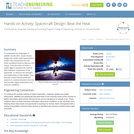
To understand the challenges of satellite construction, student teams design and create model spacecraft to protect vital components from the harsh conditions found on Mercury and Venus. They use slices of butter in plastic eggs to represent the internal data collection components of the spacecraft. To discover the strengths and weaknesses of their designs, they test their unique thermal protection systems in a planet simulation test box that provides higher temperature and pressure conditions.
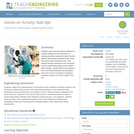
Students learn about providing healthcare in a global setting and the importance of wearing protective equipment when treating patients with infectious diseases like Ebola. They learn about biohazard suits, heat transfer through conduction and convection and the engineering design cycle. Student teams design, create and test (and improve) their own Ebola biohazard suit prototypes that cover one arm and hand, including a ventilation system to cool the inside of the suit.
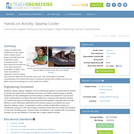
Using a household fan, cardboard box and paper towels, student teams design and build their own evaporative cooler prototype devices. They learn about the process that cools water during the evaporation of water. They make calculations to determine a room's cooling load, and thus determine the swamp cooler size. This activity adds to students' understanding of the behind-the-scenes mechanical devices that condition and move air within homes and buildings for human health and comfort.

Evaporator and types have been briefed
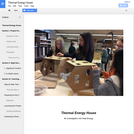
In this engineering unit, students are developing background knowledge on heat, heat transfer and conservation. While this unit can be a stand-alone exercise, it has been designed to provide a way for students to gather data and derive evidence-based conclusions to help them choose the best materials to use in a science class solar cooker project. Students build cardboard houses to explore the movement and conservation of heat energy. A heat source is placed inside the house and students use vernier temperature probes and graphing software to gather and tabulate temperature data. Each house is standard, so that the students understand that we are all gathering data in a consistent way.
Students must calculate percentage of wall space given to doors and windows. Students will compare data from team to team, examining heat loss as recorded by temperature differences as a function of window and door areas. Students will cover doors and windows with various materials, examining different insulating qualities. Students will examine the effect on temperature of different colors of wall surface on the interior of the house. After gathering data, students will work to draw conclusions from the gathering of data. Students will construct charts and tables to tabulate data by hand, then will transfer data to Excel spreadsheets if technology is available.
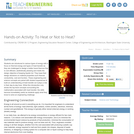
Students are introduced to various types of energy with a focus on thermal energy and types of heat transfer as they are challenged to design a better travel thermos that is cost efficient, aesthetically pleasing and meets the design objective of keeping liquids hot. They base their design decisions on material properties such thermal conductivity, cost and function. These engineering and science concepts are paired with student experiences to build an understanding of heat transfer as it plays a role in their day-to-day lives. While this introduction only shows the top-level concepts surrounding the mathematics associated with heat transfer; the skills become immediately useful as students apply what they know to solve an engineering challenge.

Principles of heat and mass transfer. Steady and transient conduction and diffusion. Radiative heat transfer. Convective transport of heat and mass in both laminar and turbulent flows. Emphasis on the development of a physical understanding of the underlying phenomena and upon the ability to solve real heat and mass transfer problems of engineering significance.
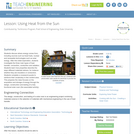
In this lesson, students will first discuss where energy comes from, including sources such as fossil fuels, nuclear, and such renewable technologies as solar. After this initial exploration, students will investigate the three main types of heat transfer: convection, conduction, and radiation. Students will learn how properties describe the ways different materials behave, for instance whether they are insulators or conductors. Students will complete a crossword puzzle to reinforce their vocabulary in this content area. The class will then focus on the acquisition and storage of energy through the design, construction, and testing of a fully functional solar oven.

This resource is a collection of student tutorial videos that explore various materials science and engineering topics using visualizations in the Wolfram Mathematica programming system.

Students learn about the definition of heat as a form of energy and how it exists in everyday life. They learn about the three types of heat transfer conduction, convection and radiation as well as the connection between heat and insulation. Their learning is aided by teacher-led class demonstrations on thermal energy and conduction. A PowerPoint® presentation and quiz are provided. This prepares students for the associated activity in which they experiment with and measure what they learned in the lesson by designing and testing insulated bottles.